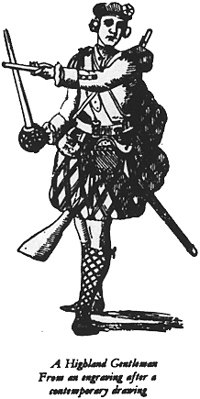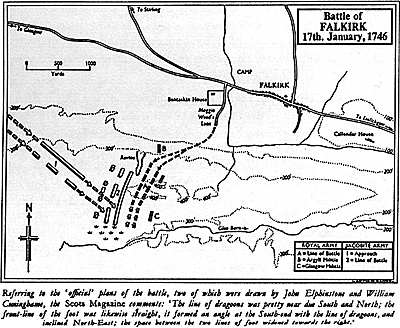 Falkirk Hill rose steeply to a heather-covered moorland plateau. The
ground was dominated by a number of irregular folds, making it difficult to
advance in a multi-battalion line , as envisioned by Hawley. The footing
would also be difficult for Hawley's dragoons, on whom he was staking so
much. Also, on the far right of the Government line, there was a large, deep
ravine, about 3/4 of the way across the slope, running from the base of the
hill to virtually the crest. This impediment would break any Government
advance up the hill into two forces incapable of providing lateral support
until the crest of the hill was cleared. Surprisingly, Hawley dismissed the
possibility of a Jacobite attack even as they advanced into view!
Falkirk Hill rose steeply to a heather-covered moorland plateau. The
ground was dominated by a number of irregular folds, making it difficult to
advance in a multi-battalion line , as envisioned by Hawley. The footing
would also be difficult for Hawley's dragoons, on whom he was staking so
much. Also, on the far right of the Government line, there was a large, deep
ravine, about 3/4 of the way across the slope, running from the base of the
hill to virtually the crest. This impediment would break any Government
advance up the hill into two forces incapable of providing lateral support
until the crest of the hill was cleared. Surprisingly, Hawley dismissed the
possibility of a Jacobite attack even as they advanced into view!
At this point Hawley became aware of the soggy ground that ringed his army and that the rainy weather had turned most of the roads and paths into quagmires. All of his artillery pieces were stuck in the mud and would have no part in the coming battle. Indeed, as the first shots were fired, the civilian drivers cut the traces and rode off with their animals, leaving Hawley's guns to the ultimate victors of the battle.
Rain
By 3:30 PM, the skies opened up and delivered cold sheets of rain into the faces of the oncoming Government soldiers, further soaking them to the bone and weighing their uniforms and equipment down and dampening their ammunition and priming pans.
Brigadier General Cholmondeley, who commanded the Government left, realized that his infantry had deployed too far to the right of the dragoons, assuring infantry support for only one regiment. The second Government line closed in on the heals of the first line before Cholmondeley could correct the mistake. Howard's Regiment could not find room to deploy into the second line, so it was held back in reserve. The Argyll (Campbell) Militia formed up in a loose column at the mouth of the ravine on the Government right, while the Glasgow Militia formed up behind the dragoons. Amazingly, Hawley's cavalry secured the crest of Falkirk Hill first.
Murray ordered an immediate "into line by the right" movement. Today, the MacDonald's of Keppoch, one of three MacDonald regiments on the field, was to hold the honorary position on the far right of the Jacobite line. In the confusion of deployment, a small company of MacGregors seized the right in a mad foot race. With no time to squabble over formalities, the Keppochs formed up on the MacGregors, somewhat incensed. Given the lay of the land it was not possible to view the entire battlefield from any one point. To complicate matters further, the Jacobites had a right wing commander in the personage of Lord Murray, but the Prince had failed to appoint a left wing commander. This error may have changed English history.
Quartermaster-General O'Sullivan, the Prince's chief advisor and Lord George's nemesis, inspected the Jacobite left and was informed by Daniel Cameron that the Government forces extended beyond the Jacobite left. O'Sullivan ordered Lord Ogilvy to march his brigade to the rear of Cameron of Lochiel's regiment instead of across the ravine from where it could have enfiladed the Government line.
Fire Discipline
As the British line advanced, Lord George ordered his men not to fire until the signal was given. This would mark the first time that the newly-drilled Highland army would have its metal tested, especially its fire discipline, which Lord George had stressed in training since the return from England.
With the light beginning to fade, Hawley ordered Colonel Francis Ligonier to attack the Jacobites with his three regiments of dragoons. Ligonier protested, pointing out that his supporting infantry had not yet deployed. Hawley snapped back and ordered him to carry out the charge order immediately. Reluctantly, Ligonier's three regiments of cavalry advanced towards Lord George and the Jacobite right. Murray ordered his men to wait for his signal to fire. The dragoons stepped gingerly over the wet ground at a walk, unable to break into a trot. At last they charged. "We held our fire as the steadiest troops in Europe..." wrote MacDonald of Lochgarry.
At ten yards, Lord George raised his pistol, the prearranged signal, and the entire Jacobite right fired as one. They emptied 80 saddles and panic seized most of the other dragoons. William Corse wrote from his position with the Glasgow militia that "we saw day light through them (the dragoons)." Lt. Colonel Whitney and a small number of his troopers hit the Highland line. Spotting John Roy Stewart, temporarily without a command, he called out, "we shall be up with you soon." Stewart drew out his broadsword and replied, "you shall be welcome when you come."
Whitney fell as soon as he hit the line and a melee with the MacDonalds was on. The Highlanders cut and slashed at the horses, bringing horses and riders crashing down. Many Highlanders went prone and slashed at the horses' bellies with their dirks. Others dragged the dragoons off their saddles and battled them on foot. Almost all of this gallant band of troopers were slain. Meanwhile, Cobham's dragoons had broken to the right, riding between the two armies and taking fire from each Jacobite battalion that it passed. Hamilton's dragoons simply bolted--over 60 ran through the Glasgow militia which was posted in their rear. At that moment, the three MacDonald regiments charged after the fleeing dragoons, ignoring Lord George's orders to hold their ground.
The MacDonald's of Keppoch headed for the Glasgow militia, a company of which were already in flight, thanks to Hamilton's panic-stricken dragoons. It was indeed Prestonpans all over again. The Argyll militia was at the head of the ravine on the Government right and bolted at the sight of Cobham's routing cavalry. The wind, rain, thunder, lightening and the fierce clan war cries combined to make for what truly must have been a scene straight out of Hell to the Government troops. Their training had never prepared them for anything like this.
Rout
Four out of six Government regiments of the front line bolted for the rear as the Highland charge rolled up the Government left wing. The regiments of Wolfe, Cholmondeley, Pulteney, and the Royals all fled. As Lord John Drummond watched the Royals flee, he said in amazement, "...these men behaved admirably at Fontenoy!"
He was, however, viewing the second battalion and not the more noted first. Ligonier's regiment (commanded by Stanhope), Prices, Barrels are all that stand. Blakeneys, Munro's and Flemings break under pressure from their comrades in the front line. Battereau attempted to fall back and line up with Howard's reserve, but the sight of the fleeing Argyll Militia and Cobham's dragoons inspire them to run too.
Surprisingly the three unrouted regiments advanced on the Jacobites, seemingly unaffected by the rout of the rest of the army! Led by Major General Huske, they align and advance. Hawley had been swept away with the rest of his command towards Falkirk. Joined by Cholmondeley, Huske's brigade fired into the flank of the pursuing Highlanders. Now the Jacobites were disordered.
Colonel John Roy Stewart suspected an ambush and ordered the Jacobites to halt. Cobhams dragoons had, by now, reformed on the extreme Government right while Lord George Murray, on the Jacobite right, ralfied the remnants of Keppoch's men and with the three battalions in the Atholl brigade, advanced.
Murray then asked the Prince to send the Jacobite reserve, by advances, to the Jacobite left to cut off the remaining Government forces under Huske. At this move, the Government forces commenced a fighting withdrawal to Falkirk, passing Hawley's mudstalled guns. Only three teams remained with their guns, but Barrel's grenadier company removed them by harnessing themselves to the cut traces and pulled them to safety with the help of the few remaining teamsters.
Murray halted his men at the bottom of the hill to re-allign and discovered that he had no more than 700 men. The rest had scattered, pursuing fugitives or having fled back to Stirling when the Government left advanced. The Prince led the Jacobite cavalry and the Irish Picquets in an advance to their left.
One Last Charge
Cobham's dragoons charged the Jacobites one more time, but they were repulsed by the steady vollies of the Irish Picquets and routed off the field. The Goverment troops fled through their camp and some attempts were made to burn the tents and wagons, but the damp weather frustrated their efforts. Three standards and two stands of colours, an abundance of powder and small arms were captured, along with Hawley's personal hangman, in Falkirk. With no one left to fight, most Highlanders drifted back towards their camp at Bannockbum, while others looted the Government camp and the Government dead.
The entire battle had taken no more than 25 minutes. Jacobite casualties were 50 dead and 80 wounded. Government losses reflected their poor performance; over 400 dead and nearly 500 wounded. The Jacobites captured 400 prisoners, the Government only one, and of course he was hanged!
Also to the scaffold went 31 of Hamilton's dragoons and 32 of the various regiments of foot were shot for cowardice and desertion. How interesting that Hawley would kill more of his own men than his entire army killed of the Jacobite army! The following day, the Royal army was back in Edinburgh, but the Jacobites returned to the siege at Stirling Castle, rather than follow up the battle with a pursuit.
The Chevalier Johnstone, an aide and observer to the Jacobite campaigns, refeffed to this episode, in his memoirs, as the "fatal resolution." Murray pleaded with the Prince to give Hawley no breathing space, but the Prince was deaf to his pleas.
On January 30, 1746, the Prince's cousin, the Duke of Cumberland, arrived in Edinburgh with reinforcements and with an order to relieve Hawley. In the end, inactivity would reduce the Highland army, by desertion, to the point where a retreat into the Highlands became inevitable. The failed siege of Stirling was abandoned and the campaign was about to enter its final phase. On April 16, 1746 the Duke of Cumberland would crush the Prince's army at Culloden and extinguish Jacobite fervor for good.
Map of Battle of Falkirk

More Falkirk Campaign of 1746
Back to Seven Years War Asso. Journal Vol. VI No. 4 Table of Contents
Back to Seven Years War Asso. Journal List of Issues
Back to Master Magazine List
© Copyright 1993 by James E. Purky
This article appears in MagWeb (Magazine Web) on the Internet World Wide Web.
Other military history articles and gaming articles are available at http://www.magweb.com